Synthesis and Characterization of a Water-Soluble Pentamethine Indocyanine Dye for Peptide Labeling †
Abstract
:1. Introduction
2. Experimental Section
2.1. Instruments and Materials
2.2. Synthesis
2.2.1. Preparation of Sulfonated Indolium Salts
2.2.2. Synthesis of Sulfo-Cy5 Carboxylic Acid 4
2.3. Photophysical Characterization
3. Results and Discussion
3.1. Synthesis of Sulfo-Cy5 Carboxylic Acid 4
3.2. Photophysical Characterization
4. Conclusions
Author Contributions
Funding
Institutional Review Board Statement
Informed Consent Statement
Data Availability Statement
Conflicts of Interest
References
- An, H.W.; Wang, M.D. The self-assembly of cyanine dyes for biomedical application in vivo. In In Vivo Self-Assembly Nano-technology for Biomedical Applications; Wang, H., Li, L.L., Eds.; Springer: Singapore, 2018; pp. 31–55. [Google Scholar]
- Zhang, X.-H.; Wang, L.-Y.; Nan, Z.-X.; Tan, S.-H.; Zhang, Z.-X. Microwave-assisted solvent-free synthesis and spectral properties of some dimethine cyanine dyes as fluorescent dyes for DNA detection. Dyes Pigm. 2008, 79, 205–209. [Google Scholar] [CrossRef]
- Patonay, G.; Salon, J.; Sowell, J.; Strekowski, L. Noncovalent labeling of biomolecules with red and near-infrared dyes. Molecules 2004, 9, 40–49. [Google Scholar] [CrossRef]
- Wang, L.; Fan, J.; Qiao, X.; Peng, X.; Dai, B.; Wang, B.; Sun, S.; Zhang, L.; Zhang, Y. Novel asymmetric Cy5 dyes: Synthesis, photostabilities and high sensitivity in protein fluorescence labeling. J. Photochem. Photobiol. A Chem. 2010, 210, 168–172. [Google Scholar] [CrossRef]
- Owens, E.A.; Bruschi, N.; Tawney, J.G.; Henary, M. A microwave-assisted and environmentally benign approach to the synthesis of near-infrared fluorescent pentamethine cyanine dyes. Dyes Pigm. 2015, 113, 27–37. [Google Scholar] [CrossRef]
- Pham, W.; Medarova, Z.; Moore, A. Synthesis and application of a water-soluble near-infrared dye for cancer detection using optical imaging. Bioconjugate Chem. 2005, 16, 735–740. [Google Scholar] [CrossRef] [PubMed]
- Wolf, N.; Kersting, L.; Herok, C.; Mihm, C.; Seibel, J. High-yielding water-soluble asymmetric cyanine dyes for labeling applications. J. Org. Chem. 2020, 85, 9751–9760. [Google Scholar] [CrossRef] [PubMed]
- Pisoni, D.S.; Todeschini, L.; Borges, A.C.A.; Petzhold, C.L.; Rodembusch, F.S.; Campo, L.F. Symmetrical and asymmetrical cyanine dyes. Synthesis, spectral properties, and BSA association study. J. Org. Chem. 2014, 79, 5511–5520. [Google Scholar] [CrossRef] [PubMed]
- Shindy, H.A. Fundamentals in the chemistry of cyanine dyes: A review. Dyes Pigm. 2017, 145, 505–513. [Google Scholar] [CrossRef]
- Bříza, T.; Rimpelová, S.; Králová, J.; Záruba, K.; Kejík, Z.; Ruml, T.; Martásek, P.; Král, V. Pentamethinium fluorescent probes: The impact of molecular structure on photophysical properties and subcellular localization. Dyes Pigm. 2014, 107, 51–59. [Google Scholar] [CrossRef]
- Yi, X.; Wang, F.; Qin, W.; Yang, X.; Yuan, J. Near-infrared fluorescent probes in cancer imaging and therapy: An emerging field. Int. J. Nanomed. 2014, 9, 1347–1365. [Google Scholar] [CrossRef] [PubMed] [Green Version]
- Luo, S.; Zhang, E.; Su, Y.; Cheng, T.; Shi, C. A review of NIR dyes in cancer targeting and imaging. Biomaterials 2011, 32, 7127–7138. [Google Scholar] [CrossRef] [PubMed]
- Feng, L.; Chen, W.; Ma, X.; Liu, S.H.; Yin, J. Near-infrared heptamethine cyanines (Cy7): From structure, property to application. Org. Biomol. Chem. 2020, 18, 9385–9397. [Google Scholar] [CrossRef] [PubMed]
- Lee, S.; Park, K.; Lee, S.-Y.; Ryu, J.H.; Park, J.W.; Ahn, H.J.; Kwon, I.C.; Youn, I.-C.; Kim, K.; Choi, K. Dark quenched matrix metalloproteinase fluorogenic probe for imaging osteoarthritis development in vivo. Bioconjugate Chem. 2008, 19, 1743–1747. [Google Scholar] [CrossRef] [PubMed]
- Jia, X.; Chen, Q.; Yang, Y.; Tang, Y.; Wang, R.; Xu, Y.; Zhu, W.; Qian, X. FRET-based mito-specific fluorescent probe for ratiometric detection and imaging of endogenous peroxynitrite: Dyad of Cy3 and Cy5. J. Am. Chem. Soc. 2016, 138, 10778–10781. [Google Scholar] [CrossRef] [PubMed]
- Mujumdar, R.B.; Ernst, L.A.; Mujumdar, S.R.; Lewis, C.J.; Waggoner, A.S. Cyanine dye labeling reagents: Sulfoindocyanine succinimidyl esters. Bioconjugate Chem. 1993, 4, 105–111. [Google Scholar] [CrossRef] [PubMed]
- Lopalco, M.; Koini, E.N.; Cho, J.K.; Bradley, M. Catch and release microwave mediated synthesis of cyanine dyes. Org. Biomol. Chem. 2009, 7, 856–859. [Google Scholar] [CrossRef] [PubMed]
- Jose, J.; Ueno, Y.; Burgess, K. Water-soluble Nile Blue derivatives: Syntheses and photophysical properties. Chem. Eur. J. 2008, 15, 418–423. [Google Scholar] [CrossRef]
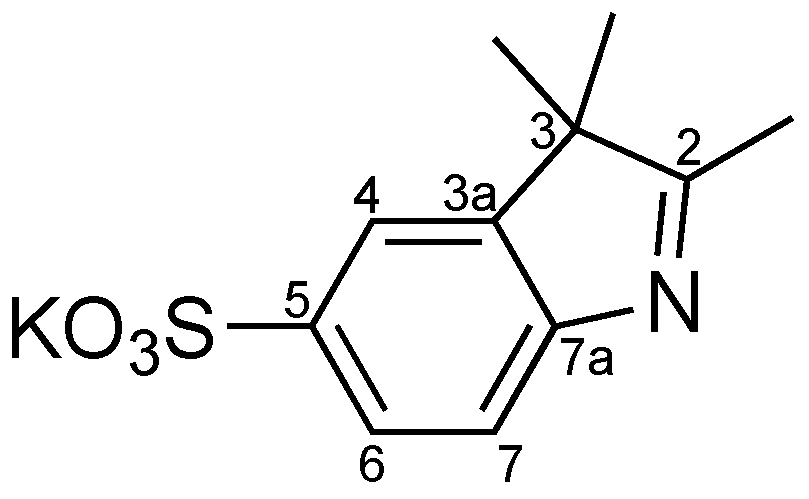
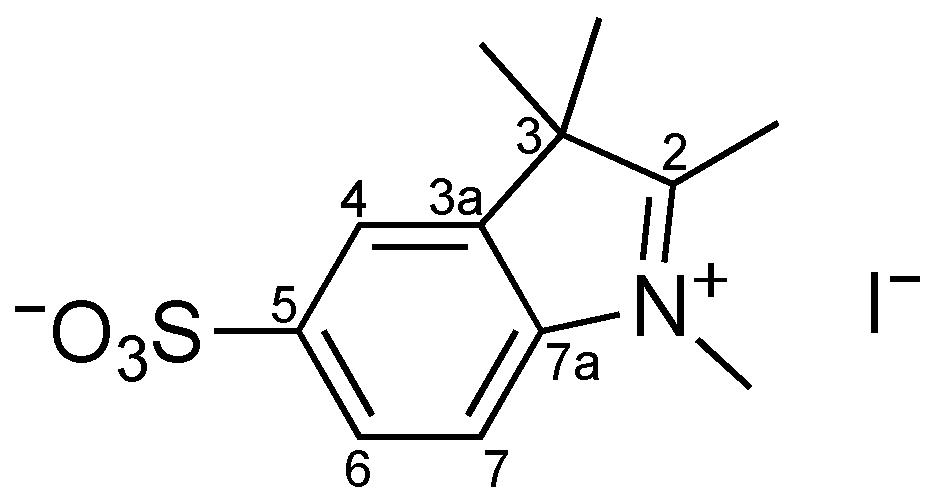
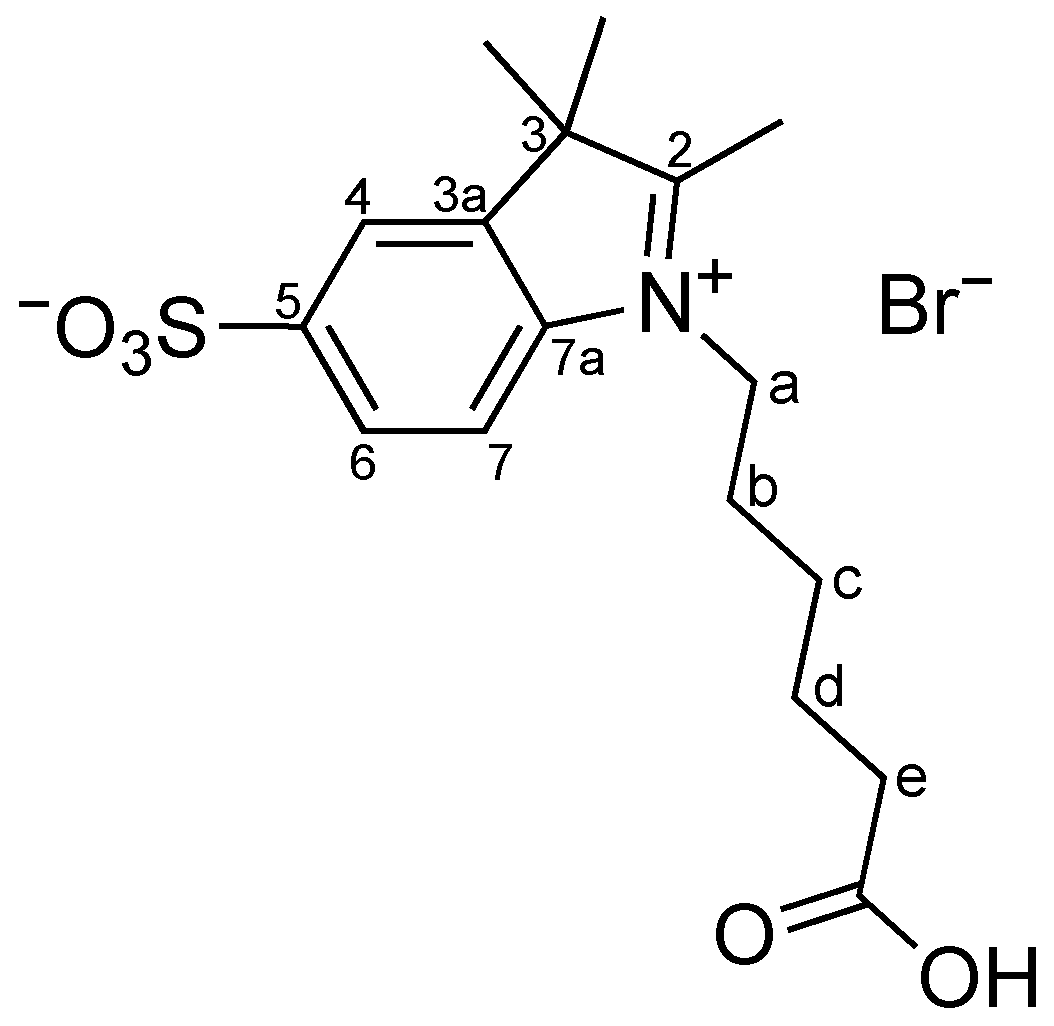
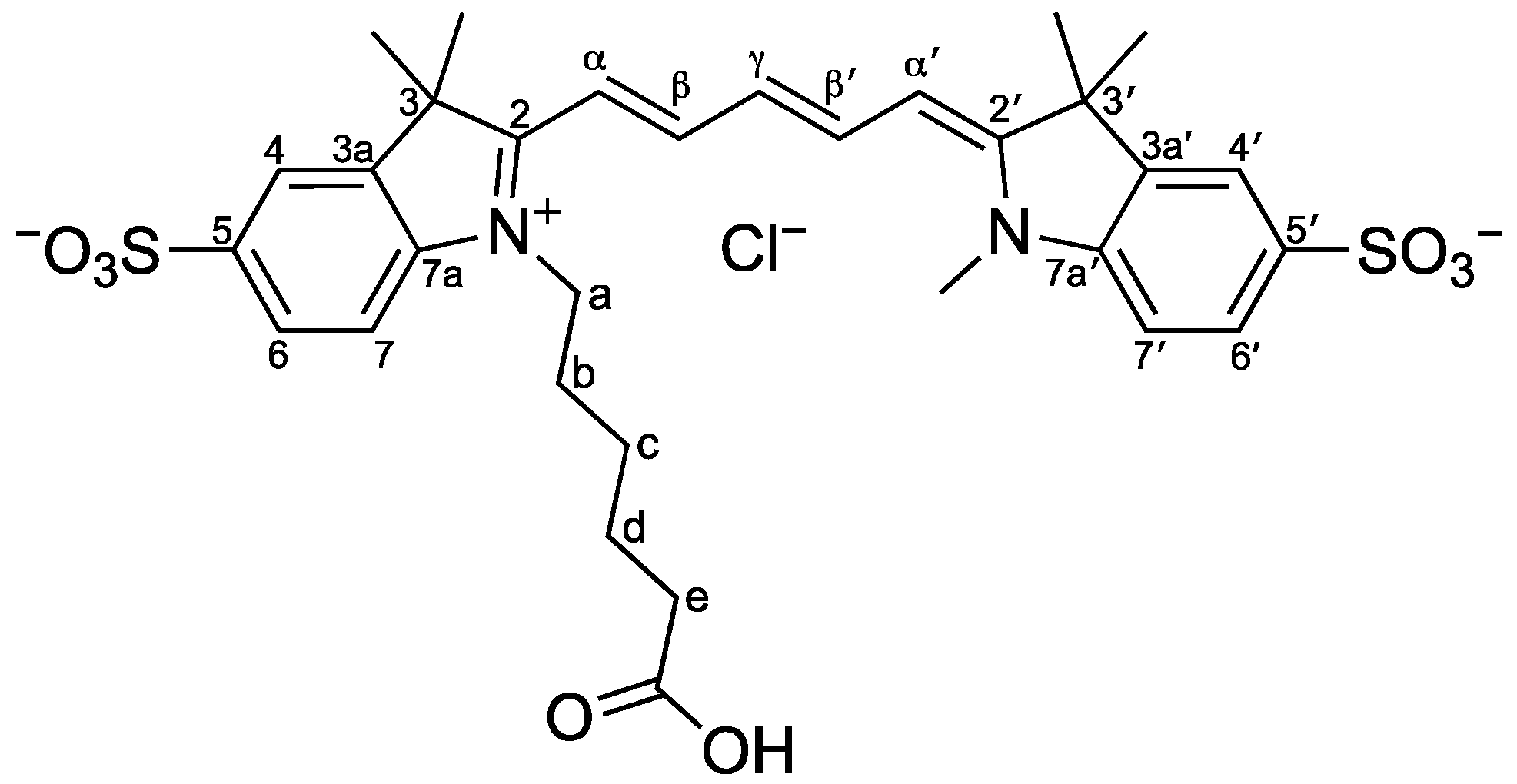

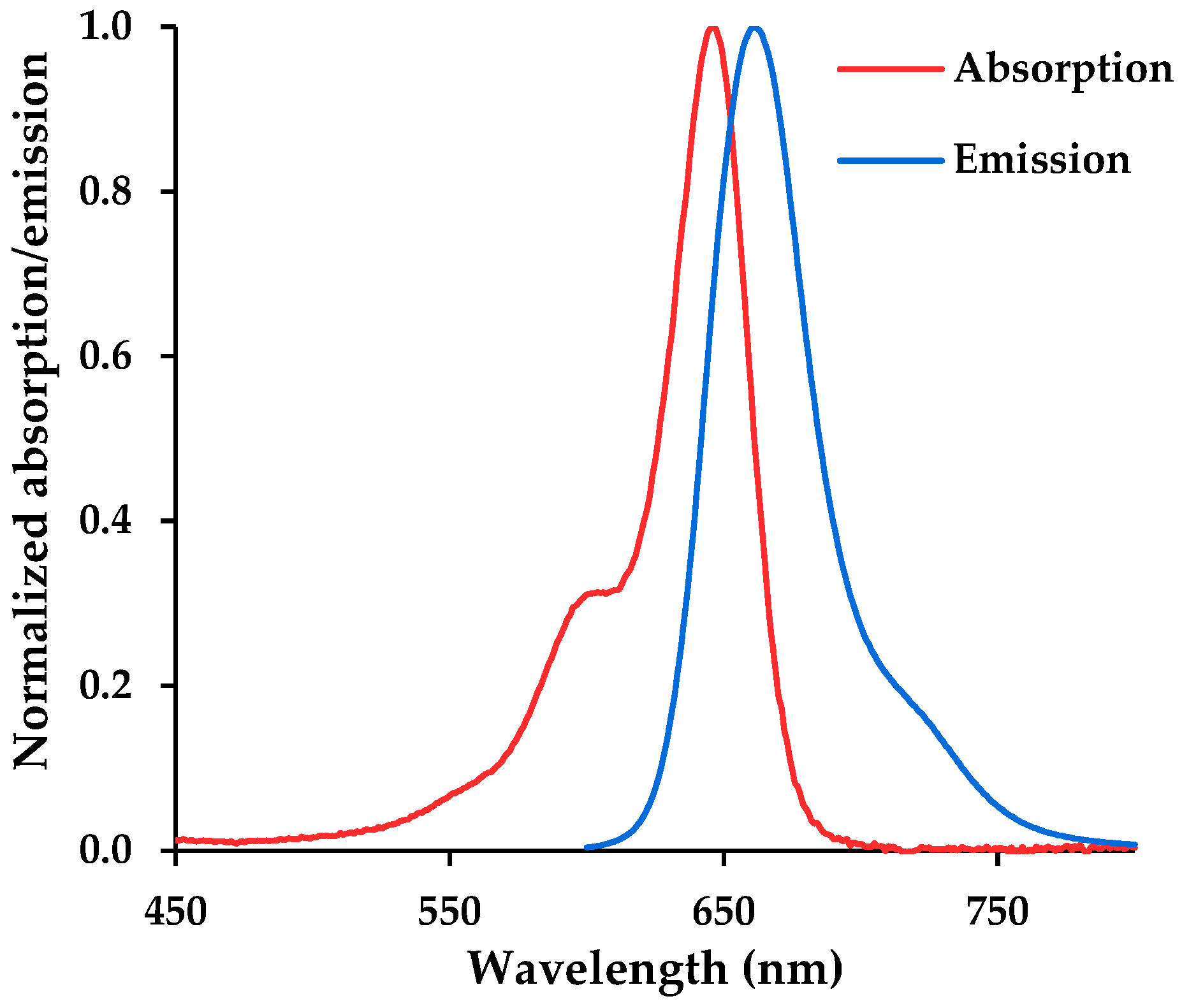
| Compound | UV-Vis Absorption | Fluorescence | |||
|---|---|---|---|---|---|
| λabs (nm) | log ε | λflu (nm) | ΦF | Stokes’ Shift | |
| Dye 4 | 646 | 5.11 | 661 | 0.27 | 15 |
Publisher’s Note: MDPI stays neutral with regard to jurisdictional claims in published maps and institutional affiliations. |
© 2022 by the authors. Licensee MDPI, Basel, Switzerland. This article is an open access article distributed under the terms and conditions of the Creative Commons Attribution (CC BY) license (https://creativecommons.org/licenses/by/4.0/).
Share and Cite
Martins, C.D.F.; Raposo, M.M.M.; Costa, S.P.G. Synthesis and Characterization of a Water-Soluble Pentamethine Indocyanine Dye for Peptide Labeling. Chem. Proc. 2022, 8, 91. https://doi.org/10.3390/ecsoc-25-11768
Martins CDF, Raposo MMM, Costa SPG. Synthesis and Characterization of a Water-Soluble Pentamethine Indocyanine Dye for Peptide Labeling. Chemistry Proceedings. 2022; 8(1):91. https://doi.org/10.3390/ecsoc-25-11768
Chicago/Turabian StyleMartins, Cátia D. F., Maria Manuela M. Raposo, and Susana P. G. Costa. 2022. "Synthesis and Characterization of a Water-Soluble Pentamethine Indocyanine Dye for Peptide Labeling" Chemistry Proceedings 8, no. 1: 91. https://doi.org/10.3390/ecsoc-25-11768
APA StyleMartins, C. D. F., Raposo, M. M. M., & Costa, S. P. G. (2022). Synthesis and Characterization of a Water-Soluble Pentamethine Indocyanine Dye for Peptide Labeling. Chemistry Proceedings, 8(1), 91. https://doi.org/10.3390/ecsoc-25-11768







